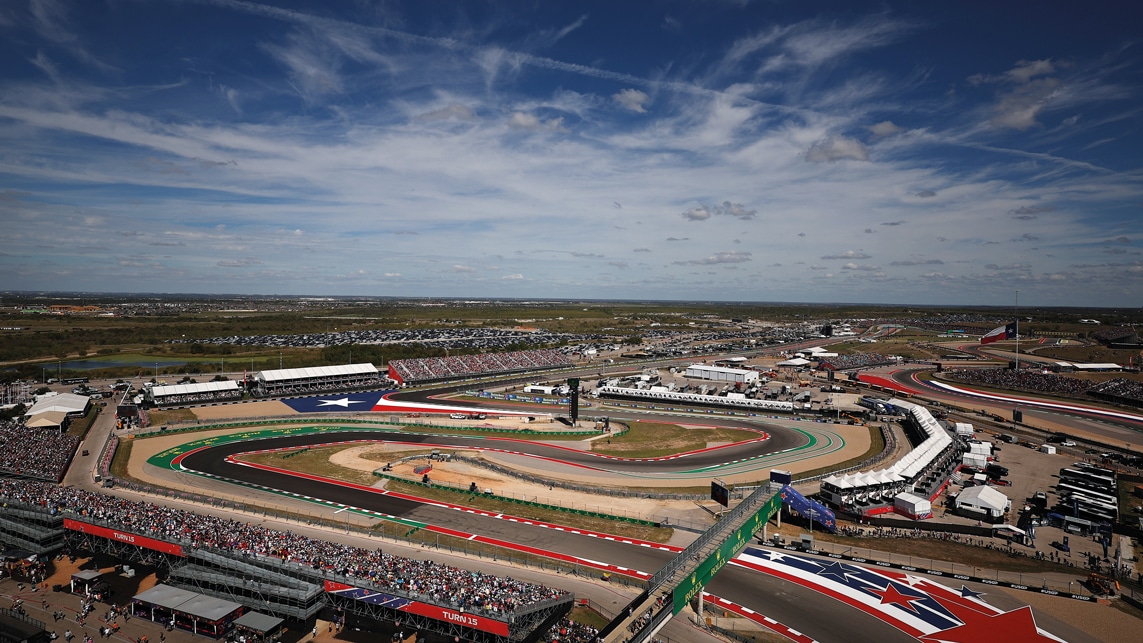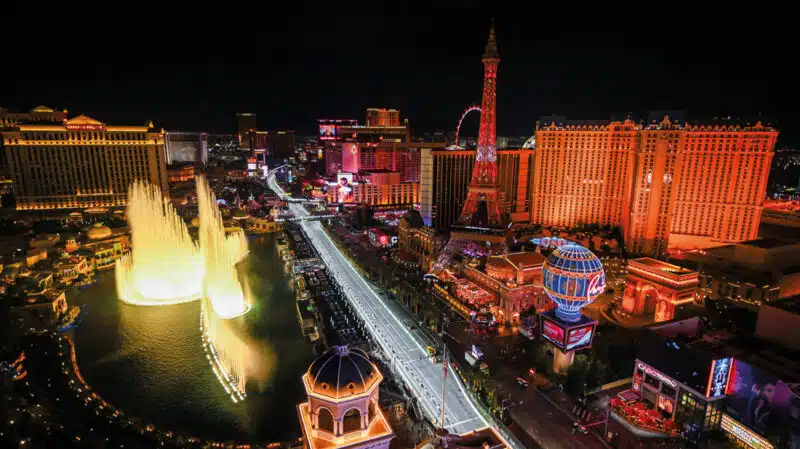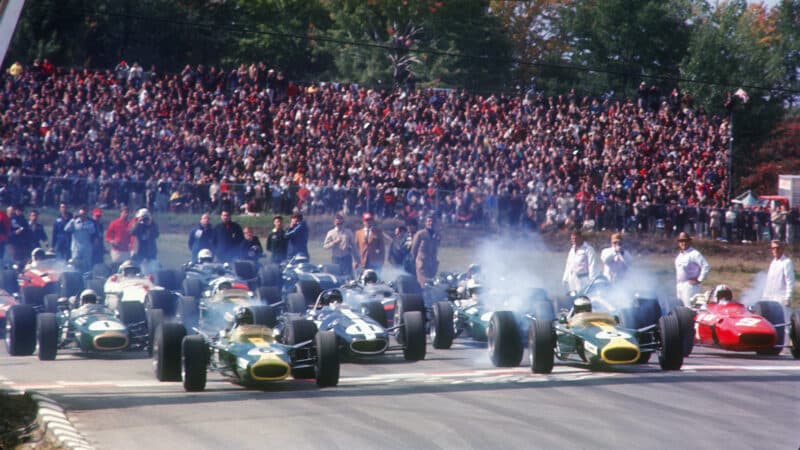The two faces of F1: why Austin and Las Vegas Grands Prix are chalk and cheese
The forthcoming two US races in Austin and Las Vegas are poles apart. Yet both are crucial for Formula 1 despite – and because of – their differences, argues Damien Smith

Austin is one of the biggest crowd-pullers on the F1 calendar
Getty Images
Two grands prix in the same country, separated by a month, different time zones and 1200 miles. Yet for what they represent in Formula 1, the Circuit of the Americas in Austin, Texas and the street race track based on The Strip in Las Vegas, Nevada might as well exist on separate planets rather than simply different US states.
The permanent COTA facility situated on the outskirts of the Texan state capital will mark its 12th United States GP on October 20 and is well established as a natural home for F1 in America – much like Watkins Glen in upstate New York during the 1960s and ’70s. The track and its vibrant, cosmopolitan ‘Keep it Weird’ city are perfectly in tune with Eurocentric F1 and a dozen years on from its memorable maiden F1 race in 2012, Austin’s round is ageing well. It belongs on the schedule – although its current deal to host the official ‘US GP’ only runs until 2026.

Not to all tastes, but the Las Vegas GP is, most likely, here to stay
Vegas by contrast is the young upstart, which will be hosting its second GP on November 24. It is everything Austin isn’t. Big, bright and brash, its appeal is rooted very much in the future of the sport as a global entertainment business rather than the more traditional feel of COTA where even the circuit design was inspired by olde world European tracks. The differences are more than skin deep too.
That’s because F1 entirely flipped its method of doing business in its desire to race under Sin City’s gaudy neon. Rather than demand many millions from a privately funded or government-backed promoter, F1 itself invested in and put on the race, in a pioneering venture that might well set the standard for future calendar additions. Although where on earth can match Vegas for sheer capitalist excess and bombast? Miami raised the bar (or lowered it depending on your point of view) when it joined the circus in 2022 – but most would admit it has nothing on Vegas, F1’s third race run in the US.
The model adopted for F1’s latest poster event involved buying a patch of prime real estate upon which to build the paddock, an investment said to be in the region of $400m (£330m) to make into reality what was once considered a long shot. Yes, it’s a street circuit and one that causes a degree of havoc for businesses and residents based on or near The Strip, but large elements of infrastructure around the temporary bits are now permanent. So shift up, locals – F1 has moved in, probably for the long-term. The initial deal actually only runs to next year, but we can take it as read Vegas is a keeper.

Not a neon sign in sight at COTA
Getty Images
Far from being a gamble, it does seem the Saturday night race was always a dead-cert safe bet for F1 rights holder Liberty Media. Just look at the published numbers. Earlier this year, the US media giant revealed F1’s overall year-on-year revenue in 2023 rose by a massive 25% from £2bn to £2.5bn, while its operating profit was up an eye-watering 64% from £185m to £300m – and Liberty made a point to heap at least a decent portion of the credit for that on its new, bedazzling GP jewel.
“Race promotion revenue grew primarily due to ticketing revenue from the inaugural Las Vegas Grand Prix and other contractual increases in fees,” Liberty stated in its annual report. “Race promotion revenue in the full year and fourth quarter also benefited from the mix of races held in each period compared to the comparable periods in the prior year. Sponsorship revenue increased due to the recognition of revenue from the Las Vegas Grand Prix income from new sponsors and growth in revenue from existing sponsors.”
This in a maiden year, as Las Vegas GP CEO Renee Wilm pointed out, when Max Verstappen had already clinched the world championship. The return fixture could well be off the scale in both hype and returns given the remarkable reboot in the competitiveness of F1 racing in the past few months. Three races from the end of the season, Vegas promises to be another Saturday night box office smash.

The Las Vegas GP Wedding Chapel
Getty Images
Then again, it would be misleading to describe COTA as the poor relation to either the Miami or Vegas GPs. On crowd numbers in 2023, Austin was one of four F1 races – along with chart-topper Silverstone, Albert Park in Melbourne and Mexico City – to exceed 400,000 in weekend attendance. COTA’s crowd figure of 432,000 did mark a drop of 8000 on the previous year, but still, it clearly remains a major draw, not only for America’s new-found F1 fanbase but also for international visitors, including the crucial influx from across the border in Mexico. The plural in the Circuit of the Americas name was entirely intentional.
The track itself remains one of the best of the Hermann Tilke era (although credit should also go to original layout designers Tavo Hellmund and 1993 MotoGP champion Kevin Schwantz). The literal nod to other F1 circuits around the world, how it draws inspiration from the Maggotts/Becketts/Chapel complex at Silverstone, the stadium section at Hockenheim and Istanbul Park’s signature Turn 8, was an obvious bid for acceptance. And to be fair, it worked. F1’s drivers back in 2012 gave it a general thumbs up and it remains popular today, especially as COTA tends to trigger decent grands prix: Lewis Hamilton’s Narain Karthikeyan-aided defeat of Sebastian Vettel in 2012; Hamilton vs Nico Rosberg in ’15; Kimi Räikkönen’s last hurrah in 2018; and Hamilton on the end of a crucial Max Verstappen defeat in 2021. In little more than a decade, COTA has shuffled in among the ‘traditional’ heartland venues and it’s one that F1 folk look forward to travelling to each year rather than convulsing in a shudder at the prospect.

More romantic than the Las Vegas Wedding Chapel – the 1967 US GP at Watkins Glen with Lotus drivers Graham Hill and Jim Clark on the front row
Grabd Prix Photo
“It would be a mistake if Austin was considered expendable”
And yet, of America’s three GPs, Austin is the one it’s easiest to imagine dropping from the schedule, if local funding dries up or another ‘big beast’ US city muscles in – such as New York (although we’ve heard that one multiple times before). F1 has long been in thrall to the new, figuratively salivating at the commercial prospects offered by a Singapore, then a Baku, then a Miami, then a Vegas. Another will come along, and already at a record-busting 24 rounds, something or somewhere will likely have to give. It would be a mistake if Austin was ever to be considered expendable.
That’s because beyond the cold, hard revenues the strength of F1’s annual schedule is its diversity: not just in terms of continents and major cities, but also the sporting spectacle it offers up. The bicycle-around-the-living-room claustrophobia of Monaco; the high-speed commitment of Silverstone, Spa, Suzuka and Monza; the night-race craze of Bahrain, Saudi, Singapore and Vegas; the dated charm of Imola and the Hungaroring – love some and hate others, they all contribute to the tapestry.

Silverstone’s Becketts complex was an obvious inspiration at COTA, along with other F1 tracks
Grand Prix Photo
No race is now bigger than the championship. We know that from how close Monaco has flirted with the chop. But F1 is better when it nurtures its traditions. Yes, Vegas is clearly good for business, whether we’re turned off by the shallow glitz and hype or find the strength to turn a blind eye. Just look at the ticket prices: a general admission ticket for Austin will, at the time of writing, set you back £354 (oof!); for Vegas, it’s more than double, at £830 (crumbs!). But we know which one we’d prefer to visit.
Austin is somehow woven into the fabric of F1’s past – even though it’s only been a dozen years. It appeals to those who loved the Glen back in the day, while still attracting the welcome fresh fanbase that has opened the floodgates to America’s new F1 love affair. Vegas might count for more in hard currency, but when it comes to F1’s indefinable strengths Austin is at least a match – and it’s certainly easier to love.
